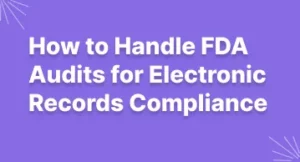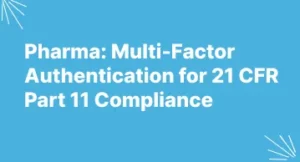Discover What the Drug Supply Chain Security Act (DSCSA) Means for You!
What is the Drug Supply Chain Security Act (DSCSA)?
The Drug Supply Chain Security Act (DSCSA) is a law of the United States that was passed in 2013 to create a national system for the regulation and collection of data about prescription drugs, along with standards and compliance requirements for pharmaceutical supply chain actors. The act was enacted in order to improve safety and security measures in the pharmaceutical distribution industry, promote an efficient and effective drug supply chain, and reduce the risk of counterfeit drugs entering the marketplace.
The DSCSA aims to create a transparent and traceable system of drug distribution wherein each drug is uniquely identified and tracked throughout its journey from the manufacturer to the patient. Each product is assigned an individual identifier which is used to collect information throughout the supply chain, allowing for the quick detection and response of counterfeit drugs and other issues.
Overview of the DSCSA
The Drug Supply Chain Security Act (DSCSA) was passed by the US Congress in 2013 as a way to ensure the safety of pharmaceuticals in the US. The purpose of the Act is to establish an electronic system for tracing and verifying the origin and movement of prescription drugs in the US wholesale market. It requires certain entities involved in the pharmaceutical supply chain, such as manufacturers, repackagors, wholesalers and distributors, to comply with regulations regarding the traceability of the medication.
The DSCSA is intended to help protect patients from buying counterfeit, mislabeled, or potentially unsafe medications.
Key Terminology
The Drug Supply Chain Security Act (DSCSA) has several key concepts and terminology that are important to understand. Some of the more common terms include:
- Traceability – The ability to track and trace a medication back to its original source through each phase of the supply chain.
- Distribution – The movement of a medication from a manufacturer, wholesaler to a retail pharmacy.
- Legitimate Transaction – A transaction at each step in the supply chain that is authentic and legal.
- Introducing Agents – Companies and individuals involved in the sale and purchase of medications between authorized parties.
- Authentication – A process whereby product identifiers on a medication are verified to be legitimate.
It is important to have a basic understanding of these terms as they will help you better understand how the DSCSA affects the pharmaceutical supply chain.
Legislative Authority of the DSCSA
The Drug Supply Chain Security Act (DSCSA) was enacted by Congress in 2013, which gives legislative authority to the Secretary of Health and Human Services (HHS) to create regulations related to the pharmaceutical supply chain. It authorizes the HHS Secretary to establish a secure system for tracking and tracing the distribution of prescription drugs, with a goal of reducing the risk of counterfeiting or fraudulent sales.
Under the DSCSA, manufacturers, wholesale distributors, repackagers, third-party logistics providers, and dispensers are required to comply with rules and regulations concerning the exchange of information about the drugs they are handling. This includes exchanging product identifiers such as National Drug Codes (NDCs) to verify drug identities and document each transaction in the supply chain.
In addition, the DSCSA requires companies in the pharmaceutical supply chain to have systems in place to detect, investigate, and report any suspect or illegitimate products in the distribution system. Manufacturers and wholesalers are also required to provide timely and complete information to other parties in the supply chain about the drug pedigree, which is an electronic record that tracks a drug from manufacturing to reaching the patient.
Historical Context: The Origins of the Drug Supply Chain Security Act
The Drug Supply Chain Security Act (DSCSA) was created in 2013 with the purpose of improving the safety and security of the pharmaceutical supply chain. Its goal is to protect patients from being administered counterfeit, contaminated, or otherwise dangerous medications that don’t meet U.S. standards. This authoritative legislation was enacted through an amendment to the Federal Food, Drug, and Cosmetic Act.
This Act was a result of several factors which have led to a weakened pharmaceutical supply chain in the United States. These include large scale distribution, a reliance on overseas manufacturers, the increasingly complex supply chain, and the rising use of counterfeit drugs. In addition, identifiers such as barcodes and verifiable data have become standard due to improvements in technology.
The DSCSA outlines specific standards for the traceability of pharmaceutical products at all stages of the supply chain. By establishing that all participants in the pharmaceutical supply chain must comply with the Act, the government aims to create a secure drug supply system which translates into improved patient outcomes in terms of safety and efficacy.
Detailed Regulatory Requirements
The Drug Supply Chain Security Act (DSCSA) enforced by the United States Food and Drug Administration (FDA) established specific requirements for pharmaceutical supply chains. Compliance with the regulations established in the Act is necessary for all participants in the supply chain, including manufacturers, repackagers, wholesale distributors, and dispensers.
Under the DSCSA, manufacturers are responsible for assigning a unique identifier, a product identifier, to each package of drug products that they label. This product identifier must adhere to the standards set forth by the FDA. It must include an identifier for the product, the National Drug Code (NDC), as well as the lot or serial number for the product.
Repackagers are required to verify the product identifier for any product they repackage and must assign a new product identifier to any repackaged product. Wholesale distributors must record the transaction information associated with any exchange of drugs as well as verify the product identifiers for product received. Dispensers must receive the product with the appropriate product identifier as well as record the transaction information related to the product.
In order to facilitate the efficient transfer of information among supply chain participants, a phased implementation of serialization and interoperable electronic systems has been put into place. These systems must be able to support the exchange, storage, and generation of transaction information and product tracing information from the manufacturer to the dispenser.
Enforcement of Regulatory Compliance
Ensuring compliance with drug supply chain regulations is paramount in keeping consumers safe. The Drug Supply Chain Security Act (DSCSA) sets out the requirements for stakeholders to follow in order to maintain an effective and secure supply chain. To ensure compliance, there are enforcement measures that have been put in place.
It is important to note that the DSCSA does not establish any specific criminal penalties for violations of its provisions. Criminal prosecution of violations is within the scope of the Federal Food, Drug and Cosmetic Act and is handled as such. However, the Act does allow other legal remedies to be taken, such as civil injunctions and administrative sanctions.
Enforcement of compliance with the Act’s provisions is carried out by the United States Food and Drug Administration (FDA). The FDA is tasked with ensuring that all entities within the supply chain are operating in accordance with the DSCSA and regulations that fall within its scope. The FDA works closely with manufacturers, wholesalers and distributors to prevent fraud, counterfeiting and diversion of drugs within the supply chain. The FDA also carries out inspections of supply chain participants to ensure they are in compliance.
By enforcing the provisions of the DSCSA, the FDA has created an improved and much safer drug supply chain. The FDA works tirelessly to protect consumer safety by promoting honesty, accuracy and accountability among all supply chain participants.
Impact of the DSCSA on the Pharmaceutical Supply Chain
The Drug Supply Chain Security Act has had an immense impact on the pharmaceutical supply chain. The Act requires all participants in the supply chain to comply with regulations to ensure product integrity and safety. This includes instituting requirements for manufacturers to serialize products which makes them easier to track, trace, and verify. These measures help to ensure that only legitimate medications and products are available in the pharmaceutical supply chain.
The Act has also implemented oversight and enforcement capabilities to ensure that regulations are followed and penalties are imposed for non-compliance. Along with this, the Act establishes a system of interoperability so that members of the supply chain are able to participate in data exchange. This helps support downstream traceability throughout the supply chain.
Although the Drug Supply Chain Security Act was created to improve the safety of patients and safeguard against counterfeit products, it has posed some challenges for industry actors. Participants in the supply chain must invest in costly infrastructure upgrades, such as serialization technology and traceability systems, in order to comply with the regulations. Furthermore, the data exchange system established by the Act has caused some technical issues, making it difficult for some participants to participate in the system.
Discussion of Challenges Encountered
Implementing the Drug Supply Chain Security Act is not without its challenges. There are multiple elements that must be taken into consideration when taking part in the pharmaceutical supply chain, including product authentication protocols, requirements for sharing product tracing information, and other compliance procedures, each of which has its own unique set of challenges.
For example, it can be difficult to ensure that all eligible parties of the supply chain have access to the necessary information to stay compliant with the Act. Additionally, designing and implementing product tracing systems that are compatible with existing technology infrastructure has proven to be difficult for many participants. Furthermore, sharing the necessary product tracing information between trading partners and maintaining data security on shared systems are two of the most pressing challenges faced by industry actors.
Knowing and understanding these challenges is paramount to successful implementation of the Drug Supply Chain Security Act.
Solutions to Downstream Data Exchange Challenges
The Drug Supply Chain Security Act (DSCSA) has enabled pharmaceutical delivery systems to become more transparent and efficient. To ensure compliance with the new regulatory framework, it is important for industry actors to understand the provisions of the Act and the challenges associated with implementing it. One such challenge is the coordination of downstream data exchange between trading partners. The exchange of product data between trading partners is essential for achieving full traceability and visibility within the pharmaceutical supply chain. Fortunately, there are remedies and alternative solutions available to entities attempting to comply with the DSCSA.
One solution involves the use of third-party service providers who specialize in data exchange services. These providers can provide a secure platform for the exchange of product data between trading partners, thereby streamlining the process. Additionally, given the complexity of the task, other software solutions may be utilized to facilitate data exchange, including enterprise resource planning systems and integrated supply chain management systems. These software programs are critical for ensuring that all the necessary product data is captured, stored, and exchanged in a secure manner.
Finally, companies must take measures to ensure that their trading partners are in full compliance with the DSCSA. This can include implementing purchasing procedures that verify the authenticity of the products being acquired, and engaging in risk-based authentication procedures to ensure the accuracy of the product data being exchanged.
By leveraging the solutions and alternative solutions discussed above, industry actors may find it easier to comply with the regulatory requirements of the Drug Supply Chain Security Act. By utilizing such solutions, companies may be better equipped to achieve full traceability and visibility of their medical products as they move through the pharmaceutical supply chain.
Summary of the Drug Supply Chain Security Act (DSCSA)
The Drug Supply Chain Security Act (DSCSA) was enacted in 2013 to create a national system for tracking pharmaceuticals throughout the supply chain. Its purpose is to help ensure that medications dispensed to patients are safe, secure, and effective. The Act outlines specific regulations that participants in the pharmaceutical supply chain must follow, which are enforced by the United States Food and Drug Administration (FDA). In short, the DSCSA provides a comprehensive framework for ensuring the safety and security of products within the pharmaceutical supply chain.
The Act requires industry-wide compliance with its regulatory requirements, such as the collection and sharing of data related to product pedigree. This proactive approach is necessary to protect consumers from counterfeit or otherwise fraudulent products. Furthermore, it helps verify the authenticity and traceability of products through the entire supply chain—from manufacturer to patient.
The DSCSA has had a major impact on the pharmaceutical supply chain. For starters, it has introduced a number of costs and complexities that participants must contend with when doing business in this industry. Additionally, there are challenges associated with the exchange of downstream data between trading partners, to allow for the traceability of products. Overcoming these challenges requires a collaborative effort between industry participants and the FDA.
In summary, the Drug Supply Chain Security Act provides a comprehensive framework for ensuring the safety and security of pharmaceutical products distributed within the United States. It requires industry-wide compliance with its regulatory requirements, introduces costs and complexities, and presents challenges to data exchange. However, with industry participants and the FDA working together, we can ensure that medications dispensed to patients are safe, secure, and effective.
Conclusion
The Drug Supply Chain Security Act is a critical piece of legislation that was passed with the intention of protecting the public from counterfeit medical products entering the supply chain. It creates a tighter, more secure system to ensure that pharmaceuticals are properly tracked and traced throughout the lifecycle and that any violations of the Act are enforceable.
By taking a close look at the DSCSA, we can see the benefit it provides to patient safety and to the healthcare sector as a whole. The Act has enabled a more secure supply chain, but has also presented some challenges to industry players. Upstream data exchange, verified product tracing, and proper medical product traceability are some of the areas that need to be addressed. Solutions are out there, and by implementing measures like blockchain technology and e-pedigree systems, stakeholders can help ensure the integrity of the pharmaceutical supply chain.
The Drug Supply Chain Security Act is an important safeguard against counterfeit products in the pharmaceutical supply chain, and it will continue to be a crucial part of our healthcare system. By understanding the Act, its regulatory requirements, and the challenges associated with compliance, we can help ensure a safer, more secure system today and into the future.
What is the Drug Supply Chain Security Act (DSCSA)?
1. What does DSCSA stand for?
Drug Supply Chain Security Act.
2. What is the purpose of DSCSA?
The purpose of DSCSA is to improve drug supply chain security by encouraging industry and government collaboration to track and trace prescription drugs through their life cycle.
3. Who is responsible for enforcing the DSCSA?
The U.S. Food and Drug Administration (FDA) is responsible for enforcing the requirements set forth by the DSCSA.
4. How will DSCSA impact pharmaceutical manufacturers, wholesalers, and pharmacies?
Pharmaceutical manufacturers, wholesalers, and pharmacies will be required to meet the requirements set forth by the DSCSA, such as electronic track and trace, verification of product information, and standardized data exchanges.
5. When does compliance with DSCSA become mandatory?
Compliance with DSCSA is mandatory starting in 2023.
6. What are the penalties for non-compliance with the DSCSA?
The penalties for non-compliance with the DSCSA can range from warnings to civil monetary penalties and possible criminal prosecution depending on the nature of the violation.
7. Are there any resources available to help learn more about DSCSA?
Yes, the FDA has several resources available including publications, webinars, and guidance documents that businesses can utilize to learn more about DSCSA.





